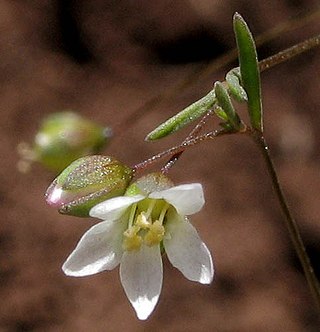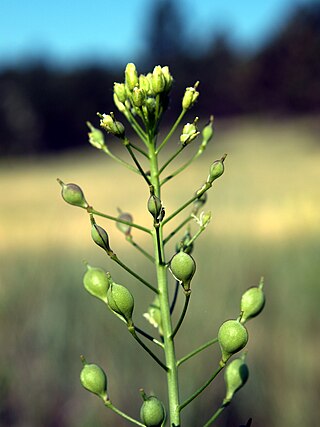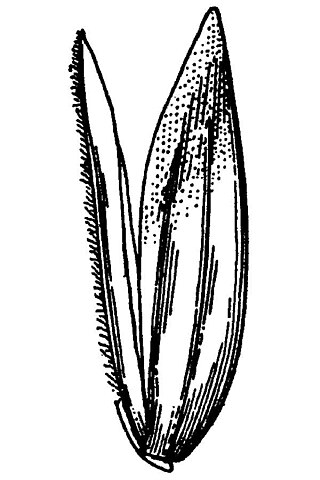
Linum (flax) is a genus of approximately 200 species in the flowering plant family Linaceae. They are native to temperate and subtropical regions of the world. The genus includes the common flax, the bast fibre of which is used to produce linen and the seeds to produce linseed oil.

Linaceae is a family of flowering plants. The family is cosmopolitan, and includes about 250 species in 14 genera, classified into two subfamilies: the Linoideae and Hugonioideae. Leaves of the Linaceae are always simple; arrangement varies from alternate to opposite or whorled. The hermaphroditic, actinomorphic flowers are pentameric or, very rarely, tetrameric.

Hesperolinon is a genus in the family Linaceae, whose common genus names are dwarf-flax or western flax, in reference to their distribution along the west coast of North America. There are 13 known species within this genus of wildflowers, most of which are limited to serpentine soil habitats within California, United States. These annual plants are thought to be mostly self-pollinating.

Hesperolinon congestum, or Marin dwarf flax, is an annual herb, which is known to occur only in San Mateo, San Francisco and Marin County, California, United States. This plant occurs chiefly on serpentine soils, especially in dry native bunch grasses, chaparral or other grasslands at elevations less than 200 meters. The flowers are congested at the tips of the dichotomously branching stems. H. congestum is in flower between April and July. The outlook for this plant depends on survival of only about twenty small colonies, most of which are not actively managed for protection, even though the species is federally and state-listed as threatened. This species is also less commonly known as Marin western flax.
Hesperolinon adenophyllum is a rare species of flowering plant in the flax family known by the common names glandular dwarf flax and glandular western flax. It is endemic to California, where most known occurrences have been recorded in Lake and Mendocino Counties. It is generally found in chaparral ecosystems on serpentine soils. This is an annual herb growing erect to heights between 10 and 50 centimeters. Its narrow, lance-shaped leaves are lined with rows of teeth with large knobby glandular points. The flower has small sepals speckled with glandular hairs and five thin yellow petals. The stamens protrude from the face of the flower and hold large yellow anthers.

Hesperolinon breweri is a rare species of flowering plant in the flax family known by the common names Brewer's dwarf flax and Brewer's western flax. It is endemic to California, where it is known from three counties in the San Francisco Bay Area. It is found in chaparral ecosystems, often on serpentine soils. This is an annual herb growing erect to a maximum height near centimeters. Its narrow, linear leaves are greenish to purplish in color. It produces dense inflorescences of flowers with glandular sepals and five bright yellow petals. The protruding stamens hold large orange-yellow anthers. This uncommon California endemic is threatened by development of its habitat but its current status is not known.
Hesperolinon californicum is a species of flowering plant in the flax family known by the common name California dwarf flax. It is endemic to California, where it grows in the coastal mountains and hills surrounding the San Francisco Bay Area and some of the foothills of the Sierra Nevada. It is found in grassland and chaparral ecosystems, often on serpentine soils. This is an annual herb growing erect to 10 to 25 centimeters in height. It has thin, narrow to threadlike leaves and produces a red exudate from resin glands located at the base of leaf petioles. The inflorescence holds several flowers with glandular sepals and five white to pink-tinged petals. The protruding stamens are tipped with large pink anthers.
Hesperolinon drymarioides is a rare species of flowering plant in the flax family known by the common names drymary dwarf flax and drymaria-like western flax; it is named for its resemblance to genus Drymaria. It is endemic to California, where it grows in the central inland North Coast Range. Most of the few known occurrences have been noted in Lake County. It is a plant of serpentine soils in chaparral and woodland ecosystems. This is a small annual herb growing a thin branching brown stem low to the ground or erect to about 20 centimeters in height. Leaves appear in whorls of four on the lower part of the stem and are dark reddish green with plentiful glandular hairs. Its flowers have light pink-veined white petals in a corolla about a centimeter across. Protruding stamens hold large yellow or purplish-white anthers.

Hesperolinon micranthum is a species of flowering plant in the flax family known by the common name smallflower dwarf flax. It is native to the west coast of North America from Oregon to Baja California. It may occur in Nevada. It grows in a number of open habitats, often on serpentine soils. This is a spindly annual herb producing a very thin stem 5 to 20 centimeters in height. Its small, sparse leaves are linear in shape. The tiny flowers have five white or pink-veined white petals each less than four millimeters long and protruding stamens with white or purple anthers.
Hesperolinon tehamense is a rare species of flowering plant in the flax family known by the common names Tehama County western flax and Paskenta Grade dwarf flax. It is endemic to northern California, where it is known from only about ten occurrences, mostly within Tehama and Glenn Counties. Most of its habitat is on Bureau of Land Management lands and within the Mendocino National Forest, in chaparral ecosystems with serpentine soils. The plant produces thin, hairy stems up to 50 centimeters in maximum height with small, sparse linear leaves. The inflorescence bears several small flowers with pale to bright yellow notched petals just a few millimeters long.

Allium cratericola is a species of wild onion known by the common name Cascade onion. It is endemic to California, where is an uncommon member of the flora in several of the state's mountain ranges, including the northern and southern California Coast Ranges, the western Transverse Ranges, Klamath Mountains, and the Sierra Nevada foothills. Its range covers much of the state, from Riverside County to Siskiyou County.
Astragalus claranus is a rare species of milkvetch known by the common names Clara Hunt's milkvetch and Napa milkvetch. It is endemic to northern California where it is known from only four or five occurrences along the border between Sonoma and Napa Counties. It is a federally listed endangered species.

Camelina microcarpa is a species of flowering plant in the mustard family known by several common names, including littlepod false flaxlesser gold-of-pleasure and small seed false flax. It is native to Europe and Asia, and it is common across the globe as an introduced species and sometimes a noxious weed. It is known as a weed of grain crops such as wheat and rye. This is an erect annual herb producing a branched or unbranched stem 30 centimeters to one meter in height. It is sometimes coated thinly in hairs, particularly on the lower part. The leaves are lance-shaped to oblong. The upper part of the stem is occupied by an inflorescence of many pale yellow flowers. They yield plump oblong to rounded fruits, each under a centimeter long and held at the tip of a short pedicel.

Galium parisiense is a species of flowering plant in the family Rubiaceae known by the common name wall bedstraw. A native of the Mediterranean area and Western Europe, it has become naturalised in North America and other parts of Europe.

Hesperolinon disjunctum is a species of flowering plant in the flax family known by the common name Coast Range dwarf flax. It is endemic to California, where it has a disjunct distribution along the North and Central Coast Ranges.

Linum grandiflorum is a species of flax known by several common names, including flowering flax, red flax, scarlet flax, and crimson flax. It is native to Algeria, but it is known elsewhere in Northern Africa, Southern Europe and in several locations in North America as an introduced species. It is an annual herb producing an erect, branching stem lined with waxy, lance-shaped leaves 1 to 2 centimeters long. The inflorescence bears flowers on pedicels several centimeters long. The flower has 5 red petals each up to 3 centimeters long and stamens tipped with anthers bearing light blue pollen. It can on occasion be found as a casual well outside its normal established range; records from the British Isles, for example, are reasonably frequent but, grown as an annual, it rarely persists for more than one season.
Lomatium repostum is an uncommon species of flowering plant in the carrot family known by the common name Napa biscuitroot, or Napa lomatium. It is endemic to California, where it is known only from the northrthern California Coast Ranges surrounding the northern San Francisco Bay Area. It often grows in plant communities on serpentine soils.

Poa napensis is a rare species of grass known by the common name Napa bluegrass. It is endemic to Napa County, California, where it is known from only two occurrences near Calistoga. It grows in moist, mineral-rich soil around hot springs. The rare grass only occurs on private, unprotected land and depends on water from the hot springs; changes to the local water regime or any other aspects of its specific habitat type would affect the plant. This grass was federally listed as an endangered species in 1997, along with another rare local hot spring endemic, the Calistoga popcornflower.
Trichostema ruygtii, with the common name Napa bluecurls, is a species of flowering plant in the mint family. It was first described to science in 2006.









